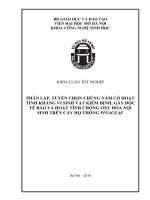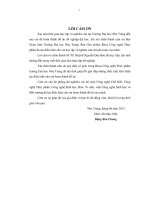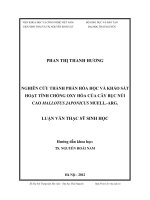Ảnh hưởng của nhóm thế và vị trí nhóm thế lên hoạt tính chống oxy hóa theo cơ chế HAT của tetrahydroxy-xanthone
Bạn đang xem bản rút gọn của tài liệu. Xem và tải ngay bản đầy đủ của tài liệu tại đây (639.5 KB, 6 trang )
����������������������������������������������������������������������������������������������������������������������������������������������������������������������������������������������������������������������������������������������������������������������������������������������������������������������������������������������������������������������������������������������������������������������������������������������������������������������������������������������������������������������������������������������������������������������������������������������������������������������������������������������������������������������������������������������������������������������������������������������������������������������������������������������������������������������������������������������������������������������������������������������������������������������������������������������������������������������������������������������������������������������������������������������������������������������������������������������������������������������������������������������������������������������������������������������������������������������������������������������������������������������������������������������������������������������������������������������������������������������������������������������������������������������������������������������������������������������������������������������������������������������������������������������������������������������������������������������������������������������������������������������������������������������������������������������������������������������������������������������������������������������������������������������������������������������������������������������������������������������������������������������������������������������������������������������������������������������������������������������������������������������������������������������������������������������������������������������������������������������������������������������������������������������������������������������������������������������������������������������������������������������������������������������������������������������������������������������������������������������������������������������������������������������������������������������������������������������������������������������������������������������������������������������������������������������������������������������������������������������������������������������������������������������������������������������������������������������������������������������������������������������������������������������������������������������������������������������������������������������������������������������������������������������������������������������������������������������������������������������������������������������������������������������������������������������������������������������������������������������������������������������������������������������������������������������������������������������������������������������������������������������������������������������������������������������������������������������������������������������������������������������������������������������������������������������������������������������������������������������������������������������������������������������������������������������������������������������������������������������������������������������������������������������������������������������������������������������������������������������������������������������������������������������������������������������������������������������������������������������������������������������������������������������������������������������������������������������������������������������������������������������������������������������������������������������������������������������������������������������������������������������������������������������������������������������������������������������������������������������������������������������������������������������������������������������������������������������������������������������������������������������������������������������������������������������������������������������������������������������������������������������������������������������������������������������������������������������������������������������������������������������������������������������������������������������������������������������������������������������������������������������������������������������������������������������������������������������������������������������������������������������������������������������������������������������������������������������������������������������������������������������������������������������������������������������������������������������������������������������������������������������������������������������������������������������������������������������������������������������������������������������������������������������������������������������������������������������������������������������������������������������������������������������������������������������������������������������������������������������������������������������������������������������������������������������������������������������������������������������������������������������������������������������������������������������������������������������������������������������������������������������������������������������������������������������������������������������������������������������������������������������������������������������������������������������������������������������������������������������������������������������������������������������������������������������������������������������������������������������������������������������������������������������������������������������������������������������������������������������������������������������������������������������������������������������������������������������������������������������������������������������������������������������������������������������������������������������������������������������������������������������������������������������������������������������������������������������������������������������������������������������������������������������������������������������������������������������������������������������������������������������������������������������������������������������������������������������������������������������������������������������������������������������������������������������������������������������������������������������������������������������������������������������������������������������������������������������������������������������������������������������������������������������������������������������������������������������������������������������������������������������������������������������������������������������������������������������������������������������������������������������������������������������������������������������������������������������������������������������������������������������������������������������������������������������������������������������������������������������������������������������������������������������������������������������������������������������������������������������������������������������������������������������������������������������������������������������������������������������������������������������������������������������������������������������������������������������������������������������������������������������������������������������������������������������������������������������������������������������������������������������������������������������������������������������������������������������������������������������������������������������������������������������������������������������������������������������������������������������������������������������������������������������������������������������������������������������������������������������������������������������������������������������������������������������������������������������������������������������������������������������������������������������������������������������������������������������������������������������������������������������������������������������������������������������������������������������������������������������������������������������������������������������������������������������������������������������������������������������������������������������������������������������������������������������������������������������������������������������������������������������������������������������������������������������������������������������������������������������������������������������������������������������������������������������������������������������������������������������������������������������������������������������������������������������������������������������������������������������������������������������������������������������������������������������������������������������������������������������������������������������������������������������������������������������������������������������������������������������������������������������������������������������������������������������������������������������������������������������������������������������������������������������������������������������������������������������������������������������������������������������������������������������������������������������������������������������������������������������������������������������������������������������������������������������������������������������������������������������������������������������������������������������������������������������������������������������������������������������������������������������������������������������������������������������������������������������������������������������������������������������������������������������������������������������������������������������������������������������������������������������������������������������������������������������������������������������������������������������������������������������������������������������������������������������������������������������������������������������������������������������������������������������������������������������������������������������������������������������������������������������������������������������������������������������������������������������������������������������������������������������������������������������������������������������������������������������������������������������������������������������������������������������������������������������������������������������������������������������������������������������������������������������������������������������������������������������������������������������������������������������������������������������������������������������������������������������������������������������������������������������������������������������������������������������������������������������������������������������������������������������������������������������������������������������������������������������������������������������������������������������������������������������������������������������������������������������������������������������������������������������������������������������������������������������������������������������������������������������������������������������������������������������������������������������������������������������������������������������������������������������������������������������������������������������������������������������������������������������������������������������������������������������������������������������������������������������������������������������������������������������������������������������������������������������������������������������������������������������������������������������������������������������������������������������������������������������������������������������������������������������������������������������������������������������������������������������������������������������������������������������������������������������������������������������������������������������������������������������������������������������������������������������������������������������������������������������������������������������������������������������������������������������������������������������������������������������������������������������������������������������������������������������������������������������������������������������������������������������������������������������������������������������������������������������������������������������������������������������������������������������������������������������������������������������������������������������������������������������������������������������������������������������������������������������������������������������������������������������������������������������������������������������������������������������������������������������������������������������������������������������������������������������������������������������������������������������������������������������������������������������������������������������������������������������������������������������������������������������������������������������������������������������������������������������������������������������������������������������������������������������������������������������������������������������������������������������������������������������������������������������������������������������������������������������������������������������������������������������������������������������������������������������������������������������������������������������������������������������������������������������������������������������������������������������������������������������������������������������������������������������������������������������������������������������������������������������������������������������������������������������������������������������������������������������������������������������������������������������������������������������������������������������������������������������������������������������������������������������������������������������������������������������������������������������������������������������������������������������������������������������������������������������������������������������������������������������������������������������������������������������������������������������������������������������������������������������������������������������������������������������������������������������������������������������������������������������������������������������������������������������������������������������������������������������������������������������������������������������������������������������������������������������������������������������������������������������������������������������������������������������������������������������������������������������������������������������������������������������������������������������������������������������������������������������������������������������������������������������������������������������������������������������������������������������������������������������������������������������������������������������������������������������������������������������������������������������������������������������������������������������������������������������������������������������������������������������������������������������������������������������������������������������������������������������������������������������������������������������������������������������������������������������������������������������������������������������������������������������������������������������������������������������������������������������������������������������������������������������������������������������������������������������������������������������������������������������������������������������������������������������������������������������������������������thiết kế, tổng hợp các hợp chất
có hoạt tính chống oxy hóa dựa trên
tetrahydroxy-xanthone.
Tài liệu tham khảo
[1] Sayre, L.M., G. Perry, and M.A. Smith, Oxidative
stress and neurotoxicity. Chem Res Toxicol, 2008.
21(1): p. 172-88.
[2] Stephens, N.G., et al., Randomised controlled trial
of vitamin E in patients with coronary disease:
Cambridge Heart Antioxidant Study (CHAOS).
Lancet, 1996. 347(9004): p. 781-6.
[3] Steinberg, D., Antioxidants and atherosclerosis. A
current assessment. Circulation, 1991. 84(3): p. 1420-5.
[4] Butterfield, D.A., beta-Amyloid-associated free
radical oxidative stress and neurotoxicity:
implications for Alzheimer's disease. Chem Res
Toxicol, 1997. 10(5): p. 495-506.
[5] Omenn, G.S., et al., Effects of a combination of beta
carotene and vitamin A on lung cancer and
cardiovascular disease. N Engl J Med, 1996.
334(18): p. 1150-5.
P.T.T.Trang, N.T.L.Anh, Đ.D.Quang / Tạp chí Khoa học và Công nghệ Đại học Duy Tân 03(40) (2020) 42-47
[6] Perron, N.R. and J.L. Brumaghim, A review of the
antioxidant mechanisms of polyphenol compounds
related to iron binding. Cell Biochem Biophys,
2009. 53(2): p. 75-100.
[7] Manach, C., A. Mazur, and A. Scalbert, Polyphenols
and prevention of cardiovascular diseases. Curr
Opin Lipidol, 2005. 16(1): p. 77-84.
[8] Jiang, F. and G.J. Dusting, Natural phenolic
compounds as cardiovascular therapeutics:
potential role of their antiinflammatory effects. Curr
Vasc Pharmacol, 2003. 1(2): p. 135-56.
[9] Wu, Z., et al., Chemical Composition and
Antioxidant Properties of Essential Oils from
Peppermint, Native Spearmint and Scotch
Spearmint. Molecules (Basel, Switzerland), 2019.
24(15): p. 2825.
[10] Stavric, B., Antimutagens and anticarcinogens in
foods. Food Chem Toxicol, 1994. 32(1): p. 79-90.
[11] Hamaguchi, T., et al., Phenolic compounds prevent
Alzheimer's pathology through different effects on
the amyloid-beta aggregation pathway. Am J
Pathol, 2009. 175(6): p. 2557-65.
[12] Hsu, S., Green tea and the skin. J Am Acad
Dermatol, 2005. 52(6): p. 1049-59.
[13] Cornwell, T., W. Cohick, and I. Raskin, Dietary
phytoestrogens and health. Phytochemistry, 2004.
65(8): p. 995-1016.
[14] Fernandez-Panchon, M.S., et al., Antioxidant Activity
of Phenolic Compounds: From In Vitro Results to In
Vivo Evidence. Critical Reviews in Food Science and
Nutrition, 2008. 48(7): p. 649-671.
[15] Pérez-González, A., et al., Reactivity Indexes and OH Bond Dissociation Energies of a Large Series of
Polyphenols: Implications for their Free Radical
Scavenging Activity. Journal of the Mexican
Chemical Society, 2012. 56: p. 241.
[16] Bowry, V.W. and K.U. Ingold, The Unexpected Role
of Vitamin E (α-Tocopherol) in the Peroxidation of
Human Low-Density Lipoprotein. Accounts of
Chemical Research, 1999. 32(1): p. 27-34.
[17] Wright, J.S., E.R. Johnson, and G.A. DiLabio,
Predicting the activity of phenolic antioxidants:
theoretical method, analysis of substituent effects,
and application to major families of antioxidants. J
Am Chem Soc, 2001. 123(6): p. 1173-83.
[18] Snelgrove, D.W., et al., Kinetic Solvent Effects on
Hydrogen-Atom
Abstractions:
Reliable,
Quantitative Predictions via a Single Empirical
Equation1. Journal of the American Chemical
Society, 2001. 123(3): p. 469-477.
47
[19] Foti, M.C., L.R.C. Barclay, and K.U. Ingold, The
Role of Hydrogen Bonding on the H-Atom-Donating
Abilities of Catechols and Naphthalene Diols and
on a Previously Overlooked Aspect of Their
Infrared Spectra. Journal of the American Chemical
Society, 2002. 124(43): p. 12881-12888.
[20] Jimenez, A., et al., Reducing activity of polyphenols
with stable radicals of the TTM series. Electron
transfer versus H-abstraction reactions in flavan-3ols. Org Lett, 2004. 6(24): p. 4583-6.
[21] Neshchadin, D., et al., Probing the Antioxidant
Activity of Polyphenols by CIDNP: From Model
Compounds to Green Tea and Red Wine. Chemistry
– A European Journal, 2010. 16(23): p. 7008-7016.
[22] Torres, J.L., et al., Tris(2,4,6-trichloro-3,5dinitrophenyl)methyl radical: a new stable coloured
magnetic species as a chemosensor for natural
polyphenols. Chemical Communications, 2003(1):
p. 74-75.
[23] Galano, A., R. Vargas, and A. Martinez,
Carotenoids can act as antioxidants by oxidizing the
superoxide radical anion. Phys Chem Chem Phys,
2010. 12(1): p. 193-200.
[24] Sueishi, Y., et al., Nitric oxide (NO) scavenging
capacity of natural antioxidants. Food Chemistry FOOD CHEM, 2011. 129: p. 866-870.
[25] Sriyatep, T., et al., Bioactive prenylated xanthones
from the young fruits and flowers of Garcinia cowa.
J Nat Prod, 2015. 78(2): p. 265-71.
[26] Mahabusarakam, W., P. Chairerk, and W.C. Taylor,
Xanthones from Garcinia cowa Roxb. latex.
Phytochemistry, 2005. 66(10): p. 1148-1153.
[27] Xia, Z., et al., Xanthones from the Leaves of
Garcinia cowa Induce Cell Cycle Arrest, Apoptosis,
and Autophagy in Cancer Cells. Molecules (Basel,
Switzerland), 2015. 20(6): p. 11387-11399.
[28] Thong, N.M., et al., Antioxidant properties of
xanthones extracted from the pericarp of Garcinia
mangostana (Mangosteen): A theoretical study.
Chemical Physics Letters, 2015. 625: p. 30-35.
[29] Galano, A., et al., Food Antioxidants: Chemical
Insights at the Molecular Level. Annual review of
food science and technology, 2016. 7: p. 335-352.
[30] Ngo, C., et al., A DFT analysis on the radical
scavenging activity of oxygenated terpenoids
present in the extract of the buds of Cleistocalyx
operculatus. RSC Advances, 2017. 7: p. 3968639698.









